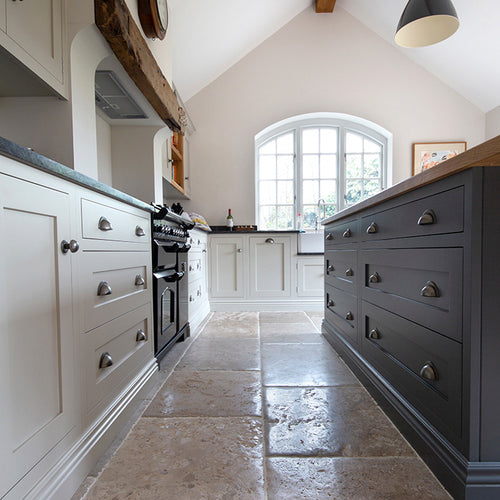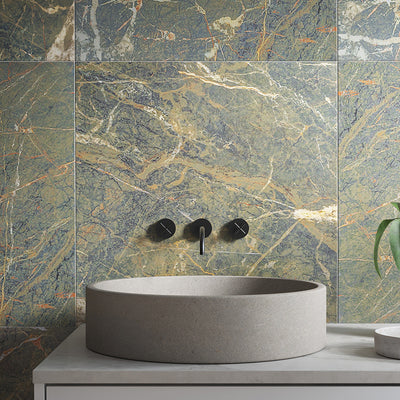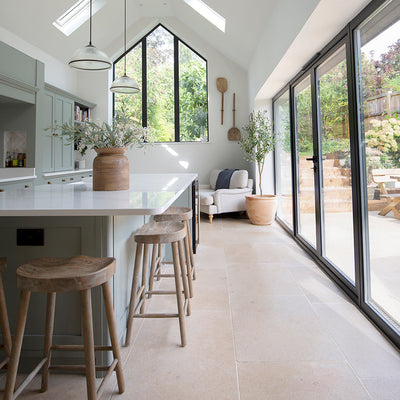How to Lay Natural Stone Tiles
In this guide we will cover how to lay natural stone tiles. Natural stone tiles are an enduring and diverse choice when it comes to floor tiles. Installed in homes for centuries, natural stone tiles are a timeless choice for any space, whether a kitchen, bathroom, or outdoor patio. The correct installation of natural stone ensures its longevity, and that your stone floor will look beautiful for years to come. Follow our helpful guide for advice on laying your natural stone floor.
Pre-installation check list
Identify your substrate: Prior to installation, it is important to identify your substrate. A substrate is the surface which sits beneath the tiles - the installation method will vary depending on your substrate and tile. We recommend employing the services of a professional installer who has experience installing on to your substrate type as well as your chosen product to achieve the best results.
Test for moisture: All substrates should be free of dust, laitance, dirt, and movement. If your substrate is a newly installed screed, it is imperative that the screed is fully cured. Either your professional installer or screed manufacturer will conduct a specialist test to understand the readiness of the screed by testing the moisture content within the screed.
Acclimatising & cleaning: Limestone and marble blocks are cut into tiles using water cooled gang saws, the tiles then undergo the appropriate finishing process and are packed immediately. Often the stone tiles retain a lot of this moisture and will not have a chance to dry until they are unpacked in a well-ventilated and heated room - as the stone starts to dry out, you will notice the colour lighten. It is important to install the tiles once fully dry to ensure you can blend the tiles tones and variation to achieve the best result.
In some instances, the tiles may require an initial clean to free them of surface dirt following the manufacturing process. This should be actioned prior to allowing the tiles to dry.
Dry laying tiles: It is best practice to dry lay your tiles initially in order to ascertain the optimum grout joints (minimum 3mm) and also to avoid any narrow cuts. This process also helps to achieve the best blend of tones and variation prior to fixing the tiles - you can inform your tiler of tiles you would prefer to use for cuts. Tiling should usually commence from the centre of the room.
Levelling existing substrates: In the instance of an uneven surface, a levelling compound such as Keratech Eco R10 can be installed (suitable for thicknesses between 1-10mm) - full application advice can be found on the Keratech Eco R10 product page. Always ensure the levelling compound is suitable for your substrate.
Materials needed
Primer: applied to the substrate prior to installation
Anti-Fracture Matting: installed between the substrate and tiles for use with underfloor heating systems
Adhesive: used to fix the tiles, as well as anti-fracture matting when required
Sealant: applied to the tile as a protective barrier against water and stains
Grout: applied between the tiles
Installation advice
Priming
We strongly recommend priming your substrate prior to installation. A primed substrate will benefit from lower absorbency and an improved bond strength. The primer required will be determined by your substrate.
Kerakoll Primer A should be used for mineral, cement, or gypsum-based substrates.
Kerakoll Keragrip should be used for wood, bitumen/asphalt, and existing tiles.
Using anti-fracture matting
If you have underfloor heating, you will need to install anti-fracture matting between the substrate and tile. Anti-fracture matting is a thin membrane designed to neutralise lateral stresses (not vertical) that occur between the substrate and tile, thus preventing cracking and possible delamination.
Please note that matting (and the adhesive required to install it) will increase the overall height of your floor by a few mm.
Fixing with adhesive
A white flexible adhesive must be used for the installation of natural stone tiles to prevent irreversible discolouration of the tiles. In some instances, certain natural stone tiles require fast set adhesive as prolonged moisture retention can cause various reactions.
A full bed of adhesive (free of air pockets) guarantees that loads are distributed evenly throughout the support layers - any voids can lead to cracked tiles. Under no circumstance should tiles be installed using the 'dot & dab' or spot fixing method as per BS 5385.
Sealing
Sealant should only be applied once the tiles are clean, fully dry and released of all moisture. We advise a minimum of two coats of sealant, one before grouting and one after grouting. Read more on how to seal natural stone tiles.
Grout
We always recommend choosing a grout colour that is similar or lighter than the floor tile. It is important not to use grout that is darker than the tile with natural stone, as this can lead to picture framing. Grouting can only take place once the initial coat of sealant has been applied.
Tiles should always be installed with a grout joint of at least 3mm. When installing an opus pattern, the grout joint will vary in width due to the layout of the tiles in the pattern. The grout joint should be able to accommodate variation within tile size where necessary.
Natural Stone Installation FAQ's
Are natural stone tiles suitable for underfloor heating?
Yes! With the correct installation, all our floor tiles are suitable for underfloor heating. We advise using an anti-fracture matting when installing the tiles and discussing any specific substrate or installation requirements with your installer.
Prior to tiling, a full commission of the UFH needs to take place, this includes both a hydraulic pressure test and thermal conditioning. The hydraulic pressure test must take place prior to the screed being poured. Following the screed curing, the screed must be thermally conditioned (run a full thermal heat cycle) to relieve stress and reveal defects. Any surface laitance/residue must be fully removed prior to this commissioning in order to assist and aid any residual moisture to escape.
Always check the commissioning process with your UFH manufacturer and screed supplier.
How should you cut natural stone tiles?
Electric cutters also known as a 'wet cutter' are best used for natural stone tiles. It is imperative that a high-quality diamond blade is used at all times - blunt or worn diamond blades can result in edge chipping. Always check the diamond blade is suitable for the type of tile you are cutting. The diamond blade picks up water as it spins, keeping both the blade and tile cool. This ensures a better cut, less friction through the tile (preventing cracking), less dust and a longer lasting blade.
In order to achieve the cleanest cuts, it is recommended to use the best cutting tools possible, as well as using a skilled operator who has extensive experience in cutting natural stone.
Do you need to clean natural stone tiles during installation?
It is important to clean the stone throughout installation to achieve the best finish. In some instances, stones may display residue from the finishing process and require a pre-install first clean. We recommend brushing any residue off with a dry brush or damp sponge. It is advisable to avoid saturating the tile as this will increase the drying time.
A post-adhesive second clean should take place prior to the tiles first coat of sealant. The sealing process will lock in any surface dust or residue, so it is important to ensure the tiles are as clean as possible. This second clean can be achieved by passing over the surface with a damp sponge.
For the post-grout final clean, we recommend Lithofin Power Clean diluted with water. The final clean should take place prior to the second coat of sealant. Begin by testing the product on two tiles, applying Lithofin Power Clean at a ratio of 1:30 to remove any ingrained residue. Use a white emulsifying pad to apply the product and leave on for 8-10 minutes, scrubbing with a white emulsifying pad or stiff brush every minute. Lightly rinse the surface to remove any residue and towel dry.
Read our blog on how to clean natural stone tiles for everyday maintenance and care.
All advice is given in good faith. The responsibility ultimately lies with your contracted installer for the correct installation of tiles.










